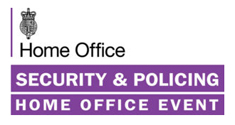DEADLINE EXTENDED! The deadline for submissions has been extended to 17:00 on Monday 1st February 2021
Entries are now open for participating exhibitors at Security & Policing 2021 to take part in industry challenges and pitch white papers to panels of experts as part of the online Fusion Forum.
Submissions will be reviewed by JSaRC and leading industry figures, and, prior to the event, the authors of selected responses will be invited to participate in S&P 2021 to ‘pitch’ their ideas in five minutes to a panel of relevant end-users and experts from Government, industry and academia. These sessions will be shown online as part of the online event content programme.
CALL FOR PARTICIPATION
Returning by popular demand, the virtual Fusion Forum will offer leading insight and promote new and integrated ways to delivering security solutions across Government, Industry and Academia. It will include a range of exciting live and on-demand online video content incorporating a blend of keynote addresses, fusion panel sessions and industry challenges.
Within the Fusion Forum, a selection of exhibiting companies will have the opportunity to ‘pitch’ white papers to panels of experts as part of a series of industry challenges set in cooperation with Government stakeholders including the Joint Security and Resilience Centre (JSaRC).
We are delighted to invite exhibitors to participate in the following industry challenges designed to identify new and integrated solutions to pertinent security issues:
- 1. Protecting National Security and the safety of children on an encrypted service
- 2. Digital Forensics for the next generation of communications
- 3. New Technologies – Considerations for Border Force
1. Protecting National Security and the safety of children on an encrypted service
The Challenge
Outline an action plan for developing and operationalising technology that would allow a company to maintain the ability to identify illegal child sexual exploitation and abuse or terrorist content and activity at scale in an encrypted service. This plan could assume the work is carried out and funded by the encrypted service itself, or by a third party such as a device or operating system provider.
Background
The Online Harms legislation aims to make the UK the safest place in the world to be online but also the best place to start and grow a digital business. This is a joint Home Office and Department for Culture, Media and Sport policy. The Home Office is particularly focussed on disrupting criminal activity online, including terrorist use of the internet and child sexual exploitation and abuse (CSEA). Terrorist content and activity and CSEA often occurs on private channels, where offenders believe their illegal activity is less likely to be detected.
The UK Government is in favour of strong encryption. It is critical to protect UK citizens from harm online and can help protect vulnerable people in repressive states. But it is clear that implementations of end-to-end encryption which intentionally blind tech companies’ access to content will have a disastrous impact on public safety.
These design choices can severely erode tech companies’ ability to identify and tackle the most serious illegal content on their platforms, including online CSEA. Currently, many companies use hashing technology such as PhotoDNA or emerging machine learning techniques to identify images and videos of child sexual abuse at scale, and law enforcement and companies save lives and safeguard children because of that technology. In the year ending June 2020, this type of industry reporting led directly to UK law enforcement arresting over 4,500 offenders and safeguarding over 6,000 children. Current methods rely on scanning un-encrypted data on company servers. One piece of research setting out possible alternatives is here
We have made clear that companies should only implement end-to-end encryption if they can do so in such a way that would not reduce public safety. We want to continue to work with the tech industry to collaborate on mutually agreeable solutions that protect public safety without compromising privacy or cyber security.
As Government continues to develop the policy on online harms, we would like to offer the opportunity for companies to present a proposal at the Security and Policing Event on potential solutions to this challenge.
2. Digital Forensics for the next generation of communications
The Challenge
What will the next generation of personal communication devices provide that the current generation doesn’t and how can these new tools be exploited for forensic investigation and/or law enforcement and security purposes?
Background
We live in a world where technology continues to evolve at pace. The general public and subjects of interest to UK Law Enforcement continue to embrace and exploit advances in personal communication technology and associated IoT devices which will provide new challenges in the prevention and detection of crime and protecting vulnerable individuals. Data is an essential part of all investigations and UK Law Enforcement needs to maintain pace with the advancements in the type of data which is managed and stored by personal communication devices. The data which is needed to support investigations includes:
- How they are communicating;
- Who they are communicating with, when that takes place and where they and the recipient are; and
- What data is being communicated.
As Government prepares for the continuous advancement of personal communication devices, we would like to offer the opportunity for companies to present a short white paper at the Security and Policing Event on potential solutions to this question.
3. New Technologies – Considerations for Border Force
Challenge
As Border Force takes advantage of new technologies, how can the UK become ‘best in class’ and what criteria should be used to assess this, taking into account GDPR privacy concerns and other ethical questions such as the safeguarding of vulnerable people?
Background
Border Force is a law enforcement command within the Home Office. Border Force secures the border and promotes national prosperity by facilitating the legitimate movement of individuals and goods, whilst preventing those that would cause harm from entering the UK. This is achieved through the immigration and customs checks carried out by our staff at ports and airports. Our officers work at 140 sea and air ports across the UK and overseas. Border Force are responsible for:
- Checking the immigration status of people arriving in and departing the UK
- Searching baggage, vehicles and cargo for illicit goods or illegal immigrants
- Patrolling the UK coastline and searching vessels
- Gathering intelligence
- Alerting the police and security services to people of interest
How to enter
Exhibitors are invited to submit proposals of up to 300 words in response to a challenge via logging in to the Exhibition Manual.
DEADLINE EXTENDED! The deadline for submissions has been extended to 17:00 on Monday 1st February 2021
All entries should mark clearly a point of contact for the submission and include a full list of organisations if a team submission.
All content appearing in the Fusion Forum is designed to be closely aligned with the aims and objectives of the UK’s Counter-Terrorism Strategy, CONTEST, and so responses are encouraged to give due regard to how Government, industry and academia can work together to:
- Disrupt threats earlier
- Share information more widely across our HMG partners
- Build resilience with our local communities
- Prioritise our efforts better overseas
- Provide a more integrated relationship with the private sector
Participants are eligible to enter submissions to more than one challenge, whether individually or as part of a team, but should not be involved in more than one entry per challenge.
All submissions will be reviewed by JSaRC and leading industry figures, and, prior to the event, the authors of selected responses will be invited to participate in S&P 2021 to ‘pitch’ their ideas in five minutes to a panel of relevant end-users and experts from Government, industry and academia. These sessions will be shown online as part of the event.

